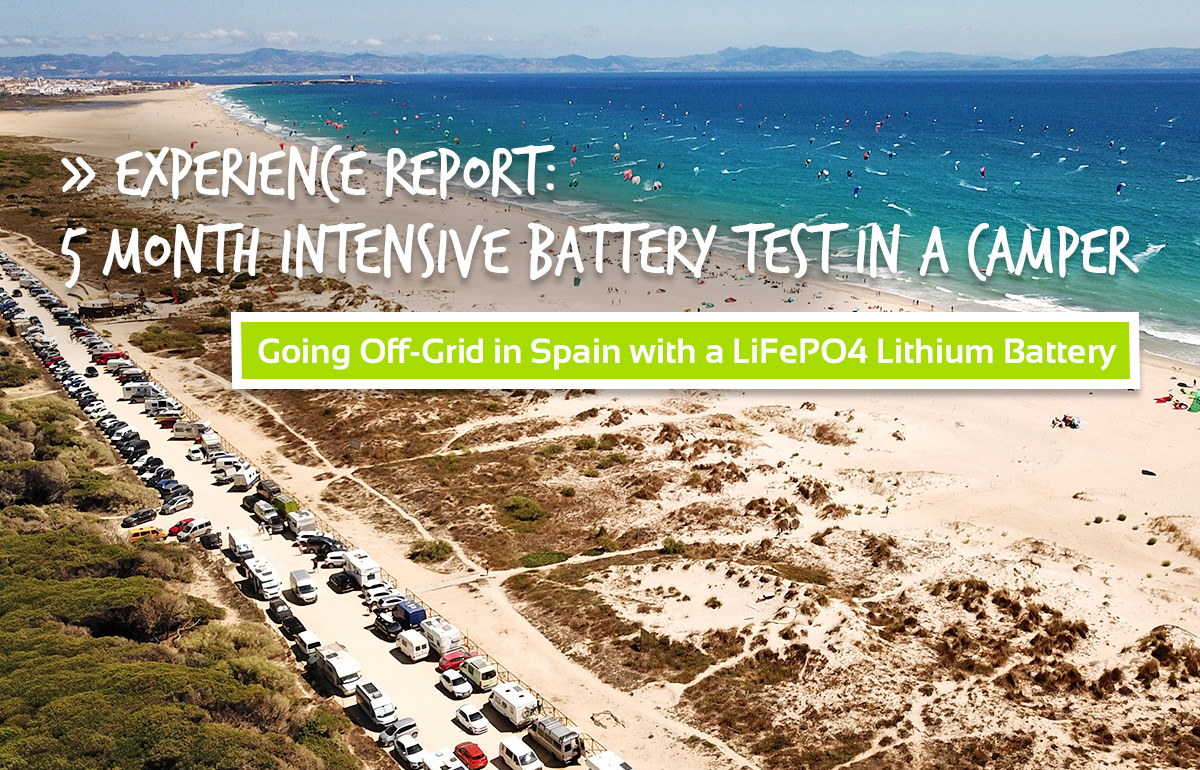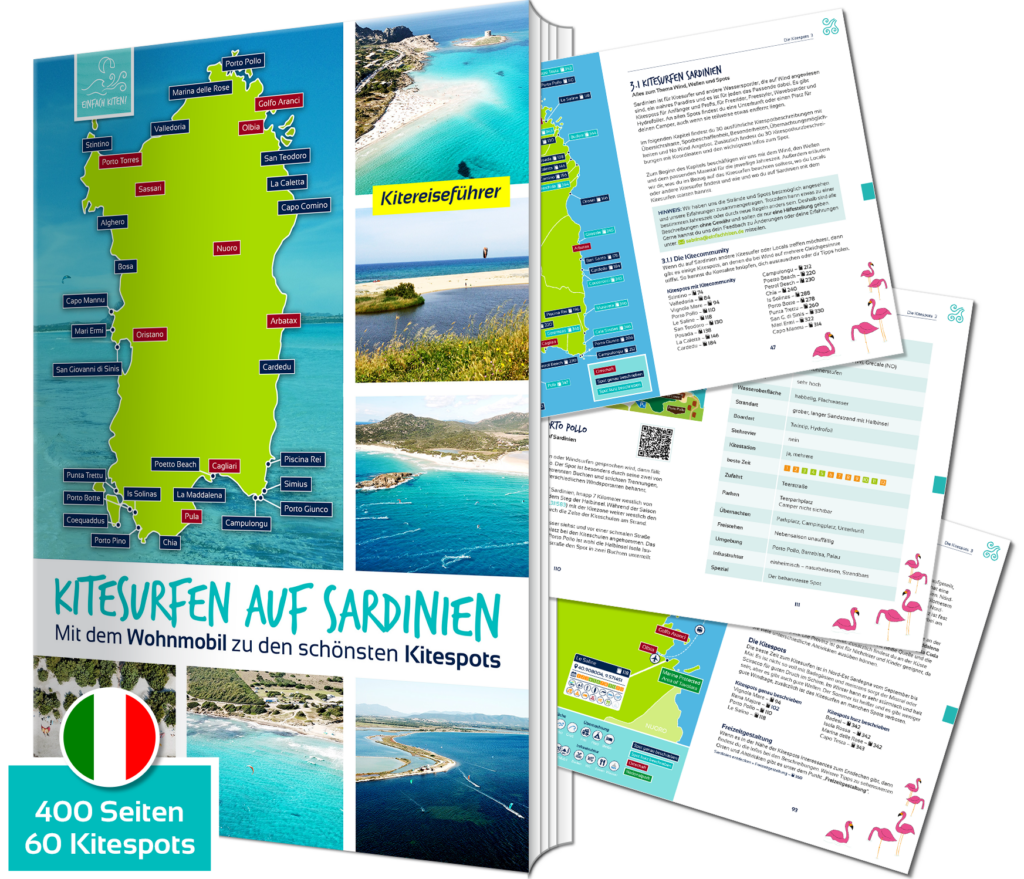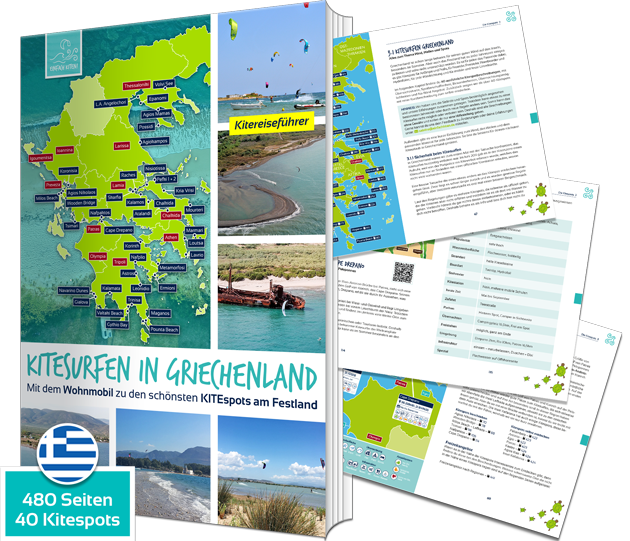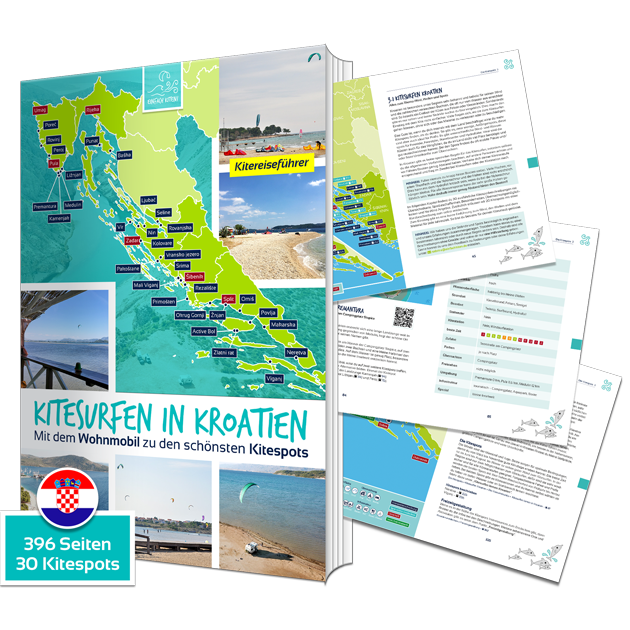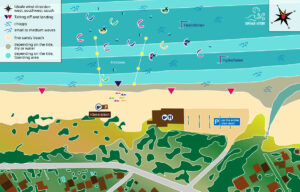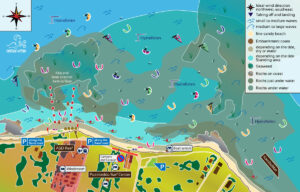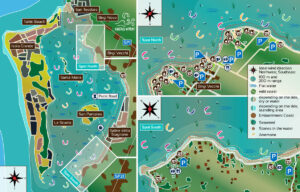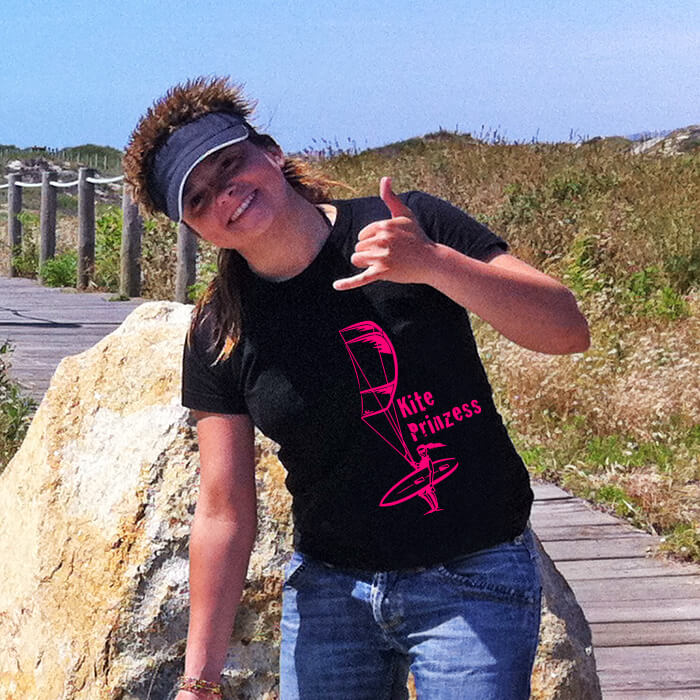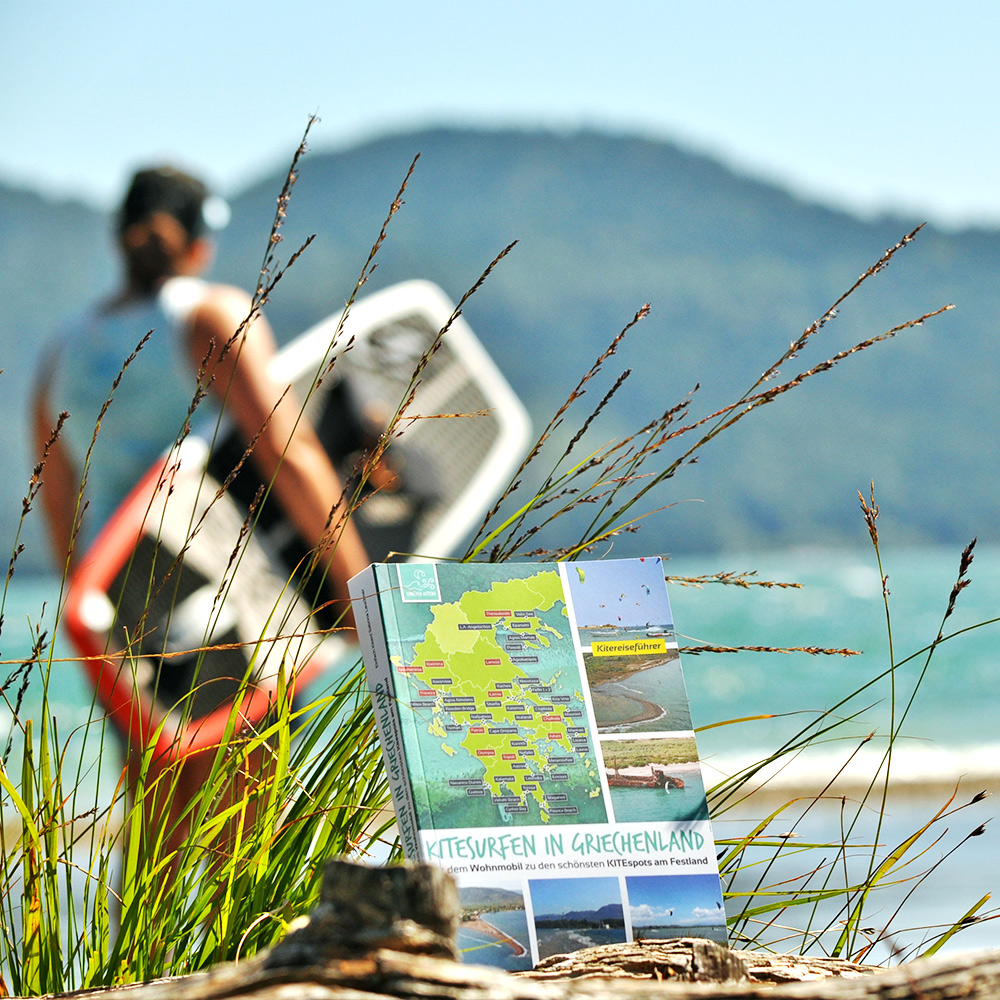In the summer of 2023, we spent five months researching for our kite travel guide to Spain, and in the process we were able to intensively test the Powerqueen’s LiFePO4 battery. In the following, you will find our experiences, recommendations and what you should pay attention to in order to always have enough power on the go.
Through our kite travel guides, we often spend months on the road in our camper exploring the best kite spots in each region. Since there are not always pitches or campsites with electricity nearby, we need to be able to supply ourselves with electricity relatively easily. It is also important that we can bridge a few days without sun, as we work on the road. But a refrigerator also wants its electricity and we don’t want to sit in the dark either. Therefore, in addition to the solar system, a good electricity storage system is very important.
In recent years, we always had a gel battery with us. Since 2023, we have switched to the 200 Ah LiFePO4 battery from Powerqueen. We did intensive research in advance. You are also welcome to read our post “LiFePO4 lithium battery test, the best option for campers“, there we have already gone into our choice of the right battery, the differences between the battery types and our collaboration with Powerqueen.
The LiFePO4 battery, a brief overview
Due to their good properties, lithium batteries are nowadays installed in many everyday objects, electrical appliances and e-cars. LiFePO4 batteries are a kind of lithium iron phosphate batteries, which differ in chemical composition and thus have different properties.
The name LiFePO4 is composed of the chemical elements lithium (Li), iron (Fe), phosphorus (P) and oxygen (O) together. The four represents the 4 oxygen atoms surrounding each iron atom in the battery. This leads to a stable structure and is the typical feature of the LiFePO4 battery.
Advantages of a LiFePO4 battery to a lithium battery
The LiFePO4 battery offers greater safety and it is less susceptible to overheating and short circuits due to its better thermal stability. In addition, it has a longer service life, is more environmentally friendly and recyclable. It also better withstands extreme ambient temperatures, which is ideal for hot countries.
Charging LiFePO4 batteries below 0 degrees or at high temperatures
The optimum temperature for charging and discharging is between 0 °C and approx. 45 °C. We had a maximum temperature in the camper of 43 °C. If you store the battery, it will withstand temperatures between -20 °C to 60 °C. You shouldn’t overdo it with extreme temperatures, though.
Most LiFePO4 batteries have an integrated BMS (Battery Management System) that monitors the charging process itself. So, if you use the battery at low temperature, the BMS may slow down the charging. Therefore, if you are more likely to travel in colder areas, there are also LiFePO4 batteries from Powerqueen with an integrated heating function, which is controlled by the BMS and you can take full advantage of the LiFePO4 battery even at low temperatures.
Disadvantages of a LiFePO4 battery to a lithium battery
On the other hand, the LiFePO4 battery has longer charging times than a lithium battery. It can also store less energy per unit weight, making it slightly heavier and larger than a lithium battery. But it is still much lighter than other types of batteries such as gel or lead and has a higher energy density. It is more expensive to buy than other types of batteries, but the purchase is worth it because of the longer life and its many positive features, especially for installation in a camper or motor home.
Our experience with the LiFePO4 battery, long-term test
From May to September we were on the road with our camper in Spain and drove about 10000 km. We had almost all weather conditions from rainy to foggy to sunny and extremely hot. Only below zero degrees was not there, but our camper is generally not designed for. But we had several days of cloudy skies, some rainy days, coastal fog and extreme sun.
Since we already had a solar system with gel battery installed in our motorhome, we have first only replaced the battery Only gradually did we adapt the system more and more, giving the LiFePO4 battery the opportunity to develop its full strength. That’s why in the beginning there were days when the battery reached its limits and we had no power. But this was simply related to the fact that we didn’t load enough for what we ended up using.
Our LiFePO4 battery has about 2500Wh and yes, with the good efficiency we can just about access the whole 2500Wh. Not like a gel or lead battery, where you can only count on half in order to preserve the battery and not damage it. With the integrated BMS (Battery Management System), we no longer have to worry about draining the battery too much, as it would lock up beforehand.
We calculated that we consume about 500Wh per day with all electrical appliances. At the beginning of our trip we were too careless with charging the battery. Then it is clear that the battery says after five days, sorry, but I have no more energy power, if you charge only 100Wh to 150Wh a day. However, it could then be recharged without any problems, the necessary first boost was sometimes simply given by our EcoFlow Powerbank and our foldable solar panel with 220 watts, which we sometimes connected extra. Our old gel battery would have stopped working long ago and would have stored almost no energy.
To help us monitor the battery, we got the right charge controller with a monitoring app from Powerqueen. The new charge controller can be easily converted to LiFePO4 batteries and the app is also very practical with Bluetooth.
At first we also thought that you can read the percentage discharge of the battery, but this only works with an extra battery monitor, which is not yet available from Powerqueen. However, it will hopefully be added in an update soon. Here the attached table, which shows the voltage of the battery in percent, can be helpful. For us, the battery monitor would also be important to see what is generally consumed in the LiFePO4 battery in terms of current, so as to have better control.
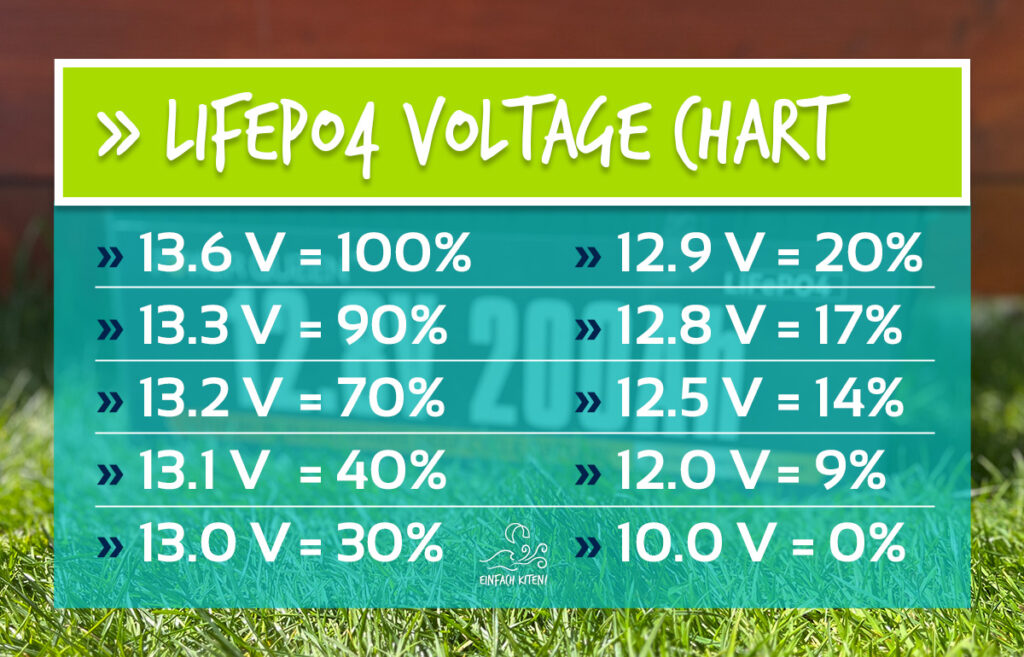
We have had about 160 watts so far with two solar panels (one is a bit older) on the roof plus the 220 watt foldable solar panel (Our experience with the foldable solar panel is in a separate post). However, the Solar usually charged the powerbank, so the battery didn’t came in the process. So now we want to upgrade our solar to about 400 watts so that the LiFePO4 battery gets its needed juice even on cloudy days. In addition, we still need to optimize charging while driving with the alternator, which is useful if you follow the wind a lot. When we are on shore power with our camper, we can charge the LiFePO4 battery with a special LiFePO4 charger from Powerqueen, which works very well.
Overall, our conclusion is very positive. Even though we had initial difficulties, especially with finding out the state of charge, we are very satisfied with the LiFePO4 battery. It still works top notch, although we did drain it a few times. The built-in BMS takes good care that it does not break. The price-performance ratio is very good and we can absolutely recommend them, especially for installation in a camper or motorhome.
It is important to know how many consumers are available and how long you want and can stand independently in one place. Then it is important to know how many hours of sunlight I can charge per day and how many watts I can generate. This determines the size of the LiFePO4 battery and the size of the solar module. Here it is up to you whether it is a permanently installed or a foldable module.
Switching to a LiFePO4 Battery in Your Camper or Motorhome: What Do I Need to Consider
During our travels we always meet other camper travelers who are either short or long term on the road. This often involves the topic of self-sufficiency on the road and how we solved this. A few questions have arisen that I would like to answer.
But the most important thing is, if you want to produce your own electricity for the motorhome to be self-sufficient everywhere, then you should be familiar with the electronics. Otherwise, it makes sense to hire a professional to prevent a cable fire or short circuit.
The easiest way is to start from scratch with nothing installed yet. So you can build your power grid well planned. If you have a finished camper, then integrating it into the existing circuit may be more difficult. That’s how it is with us.
How much electricity do I need per day in the camper or motorhome?
The first question is how many watts do I need per day, how long can I stand self-sufficiently? But no matter what the size of the respective components should be, we would now always recommend a LiFePO4 battery, because it simply has the best characteristics in terms of an RV. We have already listed these in our other post and above. Therefore, we will only go into more detail here about the installation for the LiFePO4 battery.
Our EXAMPLE for comparison
On average, we need about 500Wh a day, which is made up as follows:
- 100Wh for our cooler without freezer compartment
- 100Wh for light
- 100Wh for Iphone, drone, camera etc.
- 200Wh for laptop
This is just an approximation, of course sometimes we have 900Wh consumption and some days only 300Wh. In addition, we always have a power station with us as a backup, which has often been a great help. We can charge them every now and then at a regular outlet or with our foldable solar. (Our experience with the power station is in an extra post) With this set up we can stand 4-5 days self-sufficient, even if no sun would reach the solar panels.
How many watts of solar panel should I include?
Since we are mostly traveling in the south, we get an average of 350-450Wh a day out of a 100W solar system mounted on the roof of the camper or RV. Based on our solar output totaling 380Wh, with us deploying the foldable solar panel flexibly, our records indicate that we achieve approximately 1300Wh per day
However, this works at optimal operations when foldable solar panel is also set up. Without that, we usually only get about 500Wh out of it, so we’ll be adding to our solar on the roof as well.
Current set up:
100W solar panel on the roof
60W solar panel on the roof
220 foldable solar panel
With solar panels, it depends on how much weight and space you have available.
There are solar panels that are about 3 cm high, there are solar mats and there are mobile foldable solar panels, each has its advantages and disadvantages. Here it depends on what your roof can withstand, what you attach it to, and whether you want to load while driving or like to stand in the shade. Sometimes the mixture can also be advantageous. A module on the roof and a foldable module with it is also a good solution, as we have found.
Which solar panel is best for you with a LiFePO4 battery?
In itself, you don’t have to change anything on your solar panel, it’s just that we didn’t have enough solar capacity on the roof for our new LiFePO4 battery with lots of storage. Thus, we had problems at the beginning to get the battery full at all. Basically, the monocrystalline solar modules have prevailed among the fixed modules, because they have the best efficiency. That is, to bring the best performance to the surface.
We have two solar panels mounted on the roof boxes on our motorhome. Depending on how we park, we can open our roof boxes and point the solar panels toward the sun. When it’s too hot, we park in the shade and put the foldable solar panel next door in the sun.
How do you find the right charge controller for the LiFePO4 battery?
It is mostly written that no change of the charge controller is necessary if you change from a lead/gel battery to a LiFePO4 battery. But after more research, we discovered that there is an adjustment to be made after all. We finally decided to use a MPPT charge controller from Powerqueen, because you can simply select the LiFePO4 battery in the settings. And you can see with an app exactly what’s coming in and how much has been fed in the past.
The right charger for your LiFePO4 lithium battery
The right LiFePO4 battery charger for shore power should also be used to keep your battery optimally charged and well treated. The charger should be able to adapt the charging process to the special requirements of a LiFePO4 battery. Therefore, we did not hesitate for long and ordered the special charger for LiFePO4 batteries from Powerqueen. We have mostly attached this uncomplicated on the campsites.
Charging LiFePO4 Lithium Batteries with an Alternator
Besides shore power and solar, you can of course charge your battery while driving with the alternator. Especially if you drive a lot, charging with the alternator is a good alternative to consider in your installation. Whether you install an isolation relay or a charge booster here depends on how old the vehicle is and how much you want to spend, for one thing. In any case, there are already some specifically for LiFePO4 lithium batteries. We haven’t installed either of them yet and have definitely regretted it. In certain situations, charging via the alternator makes sense in any case. As soon as we have connected the alternator to the LiFePO4 battery, there will definitely be another update here.
Choosing the right inverter for a LiFePO4 battery
With an inverter, nothing actually needs to be changed. But with a new LiFePO4 battery, new loads are usually added and so the inverter can no longer keep up. Basically, the wattage of all loads should not be greater than your minimum inverter power.
For example, a laptop may need about 70 to 80 watts, but a water boiler 600 to 3000 watts. An air conditioner needs about 5000 watts, but this is often beyond the scope and you should rather switch to a fan. Our inverter is for 700 watts and can run at 1400 watts for a short time, which is a good average. However, it does not have a pure sine wave. For this we have our Eco Flow Powerbank.
An Overview of the Key Components for Installing a LiFePO4 Battery
- enough solar for charging
- Reprogramming or Configuring a Solar Charge Controller for Lithium/LiFePO4
- Battery Monitor for Power Output and State of Charge
- Charge booster for the alternator
- Changing or Upgrading Shore Power Charger for Lithium/LiFePO4
- Inverter with enough power
Now you can assemble your individual solar system. From the solar module on the roof, to the appropriate charge controller and battery monitor, to the LiFePO4 battery and the ideal inverter. Should you have any questions, please feel free to write to us at: hannes@einfachkiten.de.
Otherwise, we can recommend the LiFePO4 battery from Powerqueen with a clear conscience. It offers good value for money, has different sizes and so everyone will find who wants to make his camper self-sufficient. Since our test turned out so well, we will continue to work with Powerqueen in the future.

